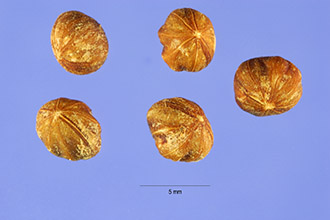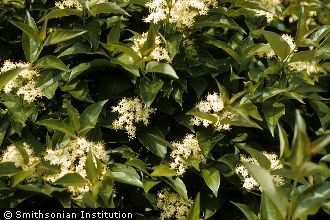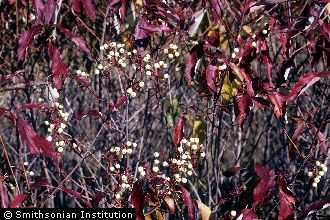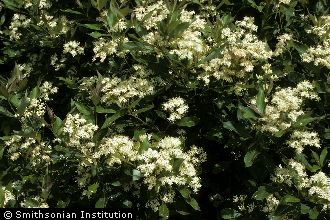Gray Dogwood
Scientific Name: Cornus racemosa Lam.

| General Information | |
|---|---|
| Usda Symbol | CORA6 |
| Group | Dicot |
| Life Cycle | Perennial |
| Growth Habits | Shrub |
| Native Locations | CORA6 |
Plant Guide
Use a soil moisture meter to monitor the soil moisture where Gray Dogwood is planted.
Fact Sheet
Uses
Gray dogwood is useful as a low-growing wild hedge which provides summer food and some cover for small animals and birds.
Status
Please consult the PLANTS Web site and your State Department of Natural Resources for this plant’s current status (e.g. threatened or endangered species, state noxious status, and wetland indicator values).
Description
Cornus racemosa Lam, gray dogwood, is a thickly branched, slow growing dogwood seldom more than 6 feet high at maturity. Its flowers, which bloom in June or July, are white and loosely clustered, and its white fruit, which appears in September and October, is set off by bright red fruit-stalks. Its leaves are opposite, taper-pointed and oval.
Adaptation
Gray dogwood has a range of adaptability equaled by few other shrubs, and it tolerates many climatic conditions. Tolerance to shade is considered intermediate. It is not well adapted to coastal plain conditions. Gray dogwood is distributed throughout the northeastern United States. For a current distribution map, please consult the Plant Profile page for this species on the PLANTS Website.
Establishment
Only seedlings of gray dogwood are practical, All should be planted as early in the spring as possible, When using dogwood for streambank planting, eroded or steep banks should be graded before planting, Plant in the early spring with dormant planting stock, Planting after May will severely reduce chances for success, One-year rooted cuttings or seedlings can be planted vertically into the bank with one or two inches of cutting wood protruding, They should be stuck in a hole large enough to accommodate the root system when well spread, The soil must be tamped well around the roots, Fresh, unrooted hardwood cuttings, easier to handle but less reliable, should be stuck vertically into the bank, leaving one to two inches above ground, A dibble can be used to make a hole, Tamp adequately to provide complete contact between the cutting and the soil, Cuttings may also be buried horizontally two inches deep in damp soil, if the ground is stony, Fresh hardwood cuttings, 3/8 to 1/2 inch at the thick end, 9 inches long, and made while dormant, are ideal, Without cold storage, planting should be done as soon as possible after cutting, Use soil moisture sensors to measure the soil moisture of Gray Dogwood., Plant both rooted cuttings and unrooted hardwood cuttings on 2 feet spacing in a diamond pattern, Chris Miller USDA NRCS Plant Materials Program When using for wildlife or screening purposes, the planting site should be cultivated to destroy existing vegetation, If not, the sod should be removed from an area two feet across for each plant, The holes should be deep enough to allow for the full extension of the roots, Spacing for hedges and screens should be staggered and 2 x 2 feet, and 4 to 5 feet for windbreaks, A small handful of fertilizer can be placed around each plant,
Management
Dogwoods used on streambanks are subject to mechanical damage. The site should be inspected annually for needed repairs in the spring after heavy runoff or ice floes. Fill in gaps by replanting or by laying down and covering branches of nearby plants. Any mechanical measures used to control the bank, such as riprap, must be kept in repair to maintain effective protection. Competing vegetation should be controlled around all dogwood plants used for hedges, screens, etc. This is particularly important during the first few years after planting.
Plant Traits
Growth Requirements
| Temperature, Minimum (°F) | -47 |
|---|---|
| Adapted to Coarse Textured Soils | No |
| Adapted to Fine Textured Soils | Yes |
| Adapted to Medium Textured Soils | Yes |
| Anaerobic Tolerance | Low |
| CaCO3 Tolerance | Low |
| Cold Stratification Required | Yes |
| Drought Tolerance | Medium |
| Fertility Requirement | Medium |
| Fire Tolerance | High |
| Frost Free Days, Minimum | 130 |
| Hedge Tolerance | Medium |
| Moisture Use | Medium |
| pH, Maximum | 7.4 |
| pH, Minimum | 4.8 |
| Planting Density per Acre, Maxim | 4800 |
| Planting Density per Acre, Minim | 1200 |
| Precipitation, Maximum | 60 |
| Precipitation, Minimum | 24 |
| Root Depth, Minimum (inches) | 16 |
| Salinity Tolerance | None |
| Shade Tolerance | Tolerant |
Morphology/Physiology
| Bloat | None |
|---|---|
| Toxicity | None |
| Resprout Ability | Yes |
| Shape and Orientation | Erect |
| Active Growth Period | Spring and Summer |
| C:N Ratio | High |
| Coppice Potential | No |
| Fall Conspicuous | No |
| Fire Resistant | No |
| Flower Color | White |
| Flower Conspicuous | Yes |
| Foliage Color | Green |
| Foliage Porosity Summer | Dense |
| Foliage Porosity Winter | Moderate |
| Foliage Texture | Coarse |
| Fruit/Seed Conspicuous | Yes |
| Nitrogen Fixation | None |
| Low Growing Grass | No |
| Lifespan | Moderate |
| Leaf Retention | No |
| Known Allelopath | No |
| Height, Mature (feet) | 10.0 |
| Height at 20 Years, Maximum (fee | 6 |
| Growth Rate | Moderate |
| Growth Form | Rhizomatous |
| Fruit/Seed Color | Brown |
Reproduction
| Vegetative Spread Rate | Slow |
|---|---|
| Small Grain | No |
| Seedling Vigor | Medium |
| Seed Spread Rate | Slow |
| Fruit/Seed Period End | Fall |
| Seed per Pound | 13000 |
| Propagated by Tubers | No |
| Propagated by Sprigs | No |
| Propagated by Sod | No |
| Propagated by Seed | Yes |
| Propagated by Corm | No |
| Propagated by Container | Yes |
| Propagated by Bulb | No |
| Propagated by Bare Root | Yes |
| Fruit/Seed Persistence | No |
| Fruit/Seed Period Begin | Spring |
| Fruit/Seed Abundance | Medium |
| Commercial Availability | Routinely Available |
| Bloom Period | Late Spring |
| Propagated by Cuttings | No |
Suitability/Use
| Veneer Product | No |
|---|---|
| Pulpwood Product | No |
| Protein Potential | Low |
| Post Product | No |
| Palatable Human | No |
| Palatable Graze Animal | Low |
| Palatable Browse Animal | Medium |
| Nursery Stock Product | No |
| Naval Store Product | No |
| Lumber Product | No |
| Fodder Product | No |
| Christmas Tree Product | No |
| Berry/Nut/Seed Product | No |



